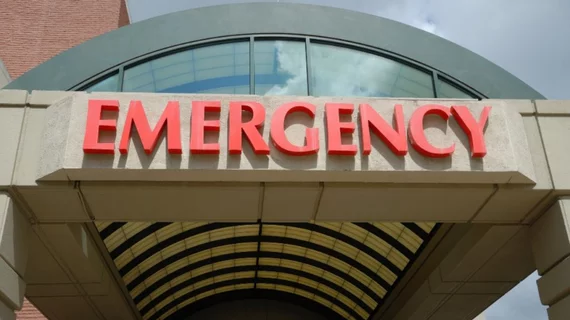Chest CT for suspected pulmonary embolism in the ED: Utilization is up, diagnostic yield is down
CT utilization in the emergency department (ED) has increased significantly in the last few decades, a fact often cited as one of the major reasons healthcare costs and radiation exposure are on the rise. So what can be done to reverse that trend?
To learn more about this issue, researchers examined the utilization and diagnostic yield of chest CT for suspected pulmonary embolism (PE) in the ED—an exam radiologists are known to order inappropriately—and published their findings in the American Journal of Roentgenology.
The authors studied Medicare data on evaluations for suspected PE in the ED from 2000 to 2009. Overall, of 2.5 million ED visits, 2.5 percent involved chest CT for suspected PE. Utilization of chest CT for suspected PE “steadily increased” from less than 1 percent in 2000 to more than 4 percent in 2009. The diagnostic yield of chest CT, however, quickly went up from 5.36 percent in 2000 to 7.31 percent in 2002, but then went back down to 5.94 percent in 2009.
“The initial increase in diagnostic yield parallels epidemiologic observations over past decades, which have reported an increased incidence of PE in the ED and substantially lower mortality than was seen in historical cohorts, suggesting that broader utilization of CT allowed earlier diagnosis and treatment of PE or diagnosis of less severe, or subsegmental, PE,” wrote A. K. Venkatesh, MD, MBA, MHS, department of emergency medicine at Yale University School of Medicine in New Haven, Connecticut, and colleagues. “The trend of declining diagnostic yields may also reflect a national shift in imaging for acute unscheduled conditions from a variety of outpatient settings to the ED as the acute-care diagnostic center, with its readily available diagnostic and treatment modalities.”
Venkatesh et al. also noted some specific trends their research uncovered at the physician level.
“First, physician experience was associated with lower utilization and increased diagnostic yield,” they wrote. “This parallels previous work suggesting that clinical experience can improve the value of clinical gestalt in physician diagnostic accuracy for suspected PE and shows the importance of clinical decision support and structured risk stratification to reduce variation among less-experienced clinicians. In addition, we found that physicians with board certification in emergency medicine were less likely to use chest CT, which may reflect the effect of formal training on the use of evidence-based diagnostic pathways for suspected PE.”
Diagnostic yield shows potential as a “complimentary, or balancing, outcome measure to utilization metrics,” the authors explained, because it can be easily measured using available data and helps show whether an exam is being ordered appropriately or not. Diagnostic yield can’t tell the story of image appropriateness on its own, however; additional context is needed before making any sweeping statements about utilization.

